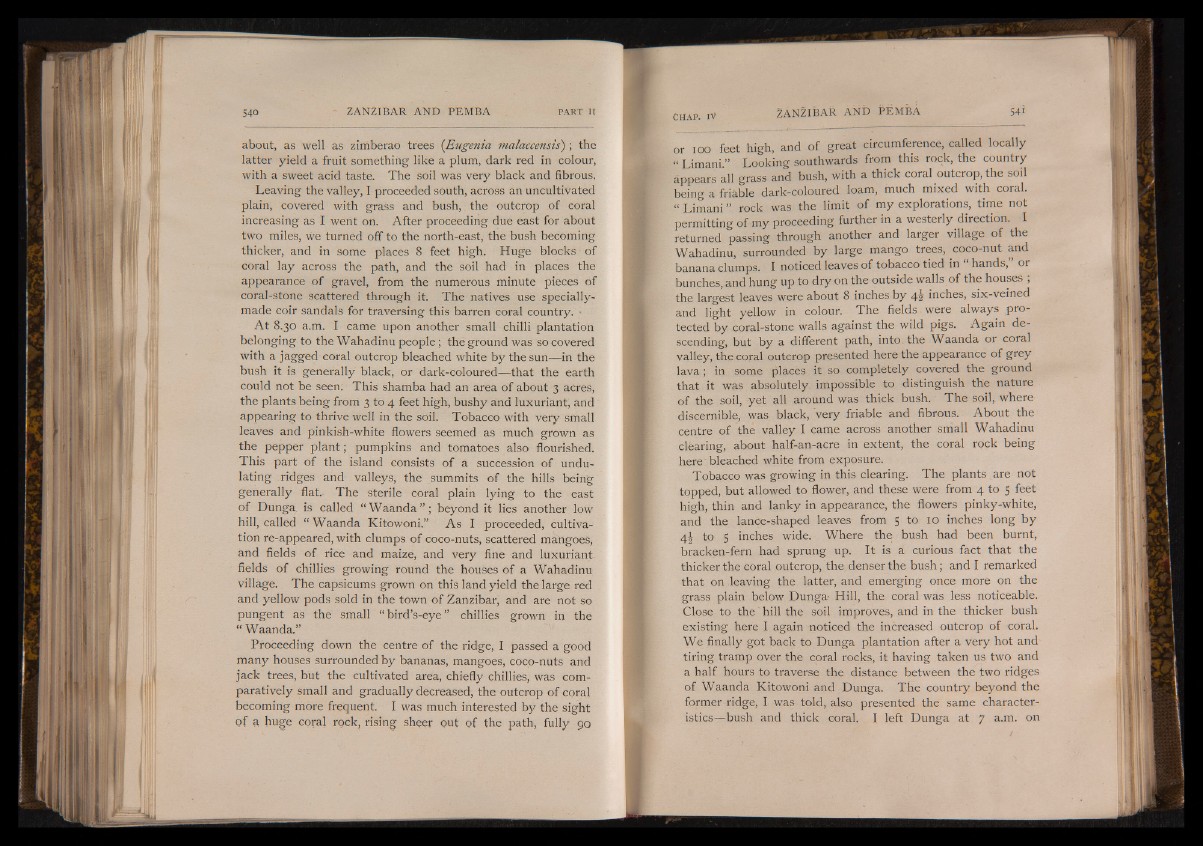
about, as well as zimberao trees (Eugenia malaccensis) ; the
latter yield a fruit something like a plum, dark red in colour,
with a sweet acid taste. The soil was very black and fibrous.
Leaving the valley, I proceeded south, across an uncultivated
plain, covered with grass and bush, the outcrop of coral
increasing as I went on. After proceeding due east for about
two miles, we turned off to the north-east, the bush becoming
thicker, and in some places 8 feet high. Huge blocks of
coral lay across the path, and the soil had in places the
appearance of gravel, from the numerous minute pieces of
coral-stone scattered through it. The natives use specially-
made coir sandals for traversing this barren coral country. •
A t 8.30 a.m. I came upon another small chilli plantation
belonging to the Wahadinu people; the ground was so covered
with a jagged coral outcrop bleached white by the sun— in the
bush it is generally black, or dark-coloured— that the earth
could not be seen: This shamba had an area of about 3 acres,
the plants being from 3 to 4 feet high, bushy and luxuriant, and
appearing to thrive well in the soil. Tobacco with very small
leaves and pinkish-white flowers seemed as much grown as
the pepper plant; pumpkins and tomatoes also flourished.
This part of the island consists of a succession of undulating
ridges and valleys, the summits of the hills being
generally flat. The sterile coral plain lying to the east
of Dunga is called “ Waanda” ; beyond it lies another low
hill, called “ Waanda Kitowoni.” As I proceeded, cultivation
re-appeared, with clumps of coco-nuts, scattered mangoes,
and fields of rice and maize, and very fine and luxuriant
fields of chillies growing round the houses of a Wahadinu
village. The capsicums grown on this land yield the large red
and yellow pods sold in the town of Zanzibar, and are not so
pungent as the small “ bird’s-eye” chillies grown in the
“ Waanda.”
Proceeding down the centre of the ridge, I passed a good
many houses surrounded by bananas, mangoes, coco-nuts and
jack trees, but the cultivated area, chiefly chillies, was comparatively
small and gradually decreased, the outcrop of coral
becoming more frequent. I was much interested by the sight
of a, huge coral rock, rising sheer out of the path, fully 90
or 100 feet high, and of great circumference, called locally
“ Limani.” Looking southwards from this rock, the country
appears all grass and bush, with a thick coral outcrop, the soil
being a friable dark-coloured loam, much mixed with coral.
“ Limani ” rock was the limit of my explorations, time not
permitting of my proceeding further in a westerly direction. I
returned passing through another and larger village of the
Wahadinu, surrounded by large mango trees, coco-nut and
banana clumps. I noticed leaves of tobacco tied in hands, or
bunches, and hung up to dry on the outside walls of the houses ;
the largest leaves were about 8 inches by 4-k inches, six-veined
and light yellow in colour. The fields , were always protected
by coral-stone walls against the wild pigs. Again descending,
but by a different path, into the Waanda or coral
valley, the coral outcrop presented here the appearance of grey
lava; in some places it so completely covered the ground
that it was absolutely impossible to distinguish the nature
of the soil, yet all around was thick bush. The soil, where
discernible, was black, very friable and fibrous. About the
centre of the valley I came across another small Wahadinu
clearing, about half-an-acre in extent, the coral rock being
here bleached white from exposure.
Tobacco was growing in this clearing. The plants are not
topped, but allowed to flower, and these were from 4 to 5 feet
high, thin and lanky in appearance, the flowers pinky-white,
and the lance-shaped leaves from 5 to 10 inches long by
M to 5 inches wide. Where the bush had been burnt,
bracken-fern had sprung up. It is a curious fact that the
thicker the coral outcrop, the denser the bush; and I remarked
that on leaving the latter, and emerging once more on the
grass plain below Dunga- Hill, the coral was less noticeable.
Close to the hill the soil improves, and in the thicker bush
existing here I again noticed the increased outcrop of coral.
We finally got back to Dunga plantation after a very hot and
tiring tramp over the coral rocks, it having taken us two and
a half hours to traverse the distance between the two ridges
of Waanda Kitowoni and Dunga. The country beyond the
former ridge, I was told, also presented the same characteristics—
bush and thick coral. I left Dunga at 7 a.m. on